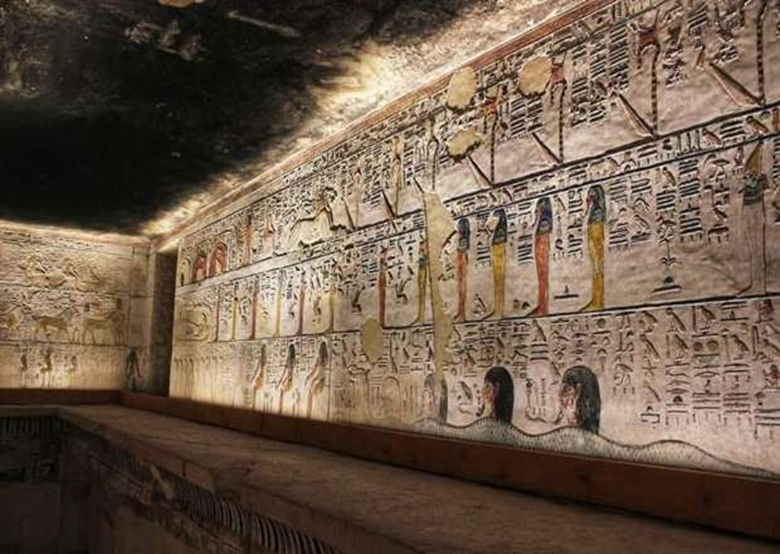The greatness of Egyptian civilization in the tombs of Seti I and Nefertari... a treasure in the Valley of the Kings

Inscriptions on the walls of Nefertari's tomb
Among the 64 tombs in the Valley of the Kings and Queens in Luxor, the tombs of Nefertari and Seti I are distinguished by a beauty and splendor rarely repeated elsewhere. Walls decorated with fine carvings, an entire ceiling colored blue to represent the sky, and strong harmony between the colors and patterns despite their differences from one place to another, a beauty that captivates visitors. Whether they are Egyptians or foreigners.
Dr. Muhammad Imam, the archaeological researcher, tells details about Nefertari’s tomb from the inside, as its walls contain exceptionally wonderful views. The entire ceiling is colored blue to represent the sky, the stars are yellow, and the columns have three colors, black at the bottom and then a red stripe while the inscriptions are on a white background. What distinguishes the tomb is the strong harmony of colors and the splendor of the engravings, and the views differed from one area to another. On the left, the visitor sees Queen Nefertari playing “sent”, which is a game similar to chess. Scholars differed in explaining the reason for photographing the deceased playing it, especially since he had no opponent. Some of them said It has a magical effect that enables one to pass safely into the other world, and some of them believe that it is to entertain the deceased on his long and arduous journey.

An Italian archaeologist discovers the tomb
The archaeological researcher adds that the tomb consists of seven rooms arranged on two levels, three on the first level, and across a short staircase there is the burial room and three other rooms, and there is also an attached room for offerings. When the Italian archaeologist Ernesto Scaparelli discovered the tomb in 1904, it was severely damaged. The walls were cracked, and a large team of scientists worked to restore the tomb from the 1920s until it became available to the public today.

?What was found in Nefertari's tomb
The archaeological researcher points out that the archaeologist Escaparelli found many scarabs, pieces of the pink coffin lid and pottery, and approximately 30 statues of the Shawabti, which are the statues that the deceased believed would serve on his behalf in the afterlife, and a very large wooden column, which represents stability. It included... On a large gilded silver plate, a small one of embossed gold, a bronze pendant and four servant statues.
Cemetery of Seti I
“Imam” explains that the second distinguished tomb is the tomb of Seti I No. 17 in the Valley of the Kings, discovered by the Italian traveler Giovanni Belzoni, and it is one of the most beautiful and complete royal tombs, measuring about 137 meters in length, and the tomb’s inscriptions include chapters from the Book of the Dead and the Emi Duat, the Book of Gates. , The Book of Heaven, and scenes of the ritual of opening the mouth, worshiping various deities.

He continued: “The tomb consists of 3 levels. After the entrance, there is a ramp with many religious texts, such as for Seti I to be worshiped in front of Ra, Hor my sister, then supplications for Ra, while the ceiling is decorated with a marble female eagle, which is one of the protective deities in ancient Egypt, and then a hall with four columns. It has scenes from the Book of the Dead on the left wall, and below it are bearers of sacrifice, while on the columns are devotional scenes, in which the deities Isis, Anubis, Hathor, and Nephthys embrace King Seti I.
According to the archaeological researcher, there is a side room attached to this hall in which there are two columns, on one of which is depicted the god Osiris, while the other has broken inscriptions. The walls are decorated with inscriptions of the sixth, seventh, and eighth hours of the book (Al-Imi-Dawat), whose name means what exists in the other world, and it is one of the religious books. The Egyptians were keen to record some of its chapters on the walls of their tombs or on papyri and placed with them in the cemetery. Then the king’s titles were inside the royal cartouches, protected by the two protective deities Nakheptet and Wajit.

At the end of the room there is a long corridor leading to the burial chamber, where Belzoni found the king’s coffin made of alabaster and currently preserved in the John Soanes Museum in London, with chapters from the Book of Gates engraved on it. The ancient Egyptians believed that the deceased passed through twelve gates. In the other world, he must know its names and the names of its guards so that he can cross it and reach the fields of bliss called “Sakhet Iyaru.” And inside the coffin is the image of the goddess Nut, the goddess of the sky, opening her arms as if she is embracing the mummy of the king lying in the coffin.
Source : websites

